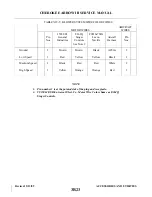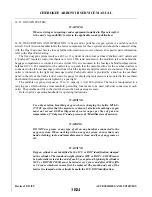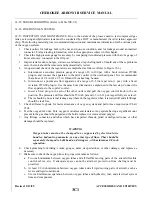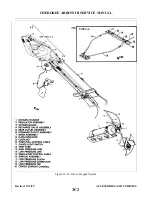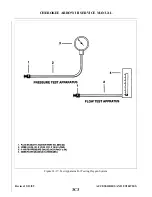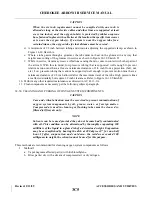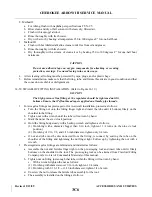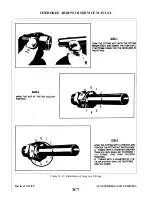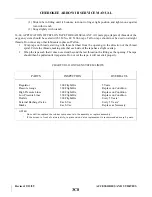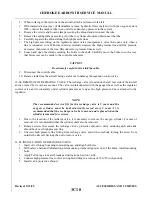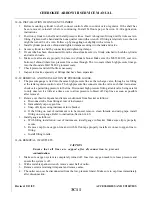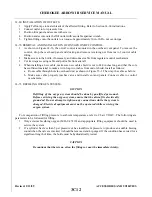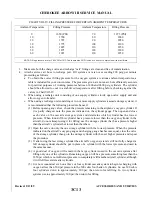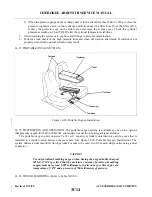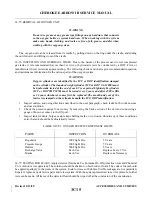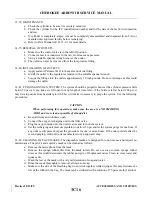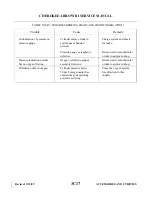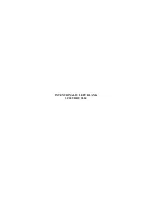
CHART VIII-IV. FILLING PRESSURE FOR CERTAIN AMBIENT TEMPERATURES
Ambient Temperature
Filling Pressure
Ambient Temperature
Filling Pressure
0
1650 (PSI)
70
1975 (PSI)
10
1700
80
2000
20
1725
90
2050
30
1775
100
2100
40
1825
110
2150
50
1875
120
2200
60
1925
130
2250
NOTE: Filling pressure are for 1850 PSI
a
t 70°F. Table
ass
ume
s
25°F ri
s
e due to he
a
t of comprssion with ma
x fill rate.
3. Make sure both the charge valve and recharge “cart” fittings are clean and free of contamination.
4. Attach service cart hose to recharge port. Fill system at a rate not exceeding 200 psig per minute
proceeding as follows:
a.
To obtain the correct filling pressure for the oxygen system at various ambient temperatures, a
table is included for your convenience. The pressures given are not exact, but sufficiently accurate
for practical purposes of working pressures between 1800 and 2400 psig cylinders. The cylinder
should be allowed to cool to a stabilized temperature after filling before checking against the
valves in Chart VIII-IV.
b. When using a recharge unit consisting of one supply cylinder, slowly open valve supply unit and
allow oxygen to transfer.
c.
When using a recharge unit consisting of two or more supply cylinders (cascade storage system), it
is recommended that the following procedure be used:
(1) Before opening any valves, check the pressure remaining in the airplane’s oxygen cylinder. If
it is partly charged, note the pressure indicated on the cylinder gauge. Then open and close
each valve on the cascade storage system and determine which cylinder has the lowest
pressure. When found if this cylinder has a pressure lower than the oxygen cylinder in the
aircraft, do not attempt using it for filling; use the storage cylinder that has a pressure higher
than the aircraft’s cylinder but lower than the others.
(2) Open the valve on only the one storage cylinder with the lowest pressure. When the pressure
indicated on the aircraft’s oxygen gauge and charging gauge has become equal, close the valve
of the storage cylinder, then go to the storage cylinder with the next higher pressure and repeat
the procedure.
(3) If after using the last storage cylinder the aircraft’s oxygen system is still not fully charged, a
full storage cylinder should be put in place of a cylinder with the lowest pressure and used in
the same manner.
(4) A good deal of oxygen will remain in the large cylinders used in the cascade system after
filling only one of the cylinders. Remaining oxygen will be a pressure something less than the
1850 psi which is not sufficient pressure to completely refill another aircraft cylinder, although
it will refill several smaller cylinders.
(5) It is not economical even on a three or four cylinder cascade system to begin recharging with
oxygen at less than 300 psi pressure in the 300 cubic foot bank of cylinders. So use 300 cubic
foot cylinders down to approximately 300 psi; then return for refilling. In two cylinder
systems use to approximately 100 psi; then return for filling.
Revised: 2/13/89
3C13
CHEROKEE ARROW III SERVICE MANUAL
ACCESSORIES AND UTILITIES
Summary of Contents for ARROW III
Page 4: ...THIS PAGE INTENTIONALLY LEFT BLANK 1A4...
Page 12: ...THIS PAGE INTENTIONALLY LEFT BLANK 1A12...
Page 94: ...Figure 4 2 Wing Installation Revised 2 13 89 1D22 CHEROKEE ARROW III SERVICE MANUAL STRUCTURES...
Page 171: ...lH3 INTENTIONALLY LEFT BLANK...
Page 172: ...lH4 INTENTIONALLY LEFT BLANK...
Page 286: ...THIS PAGE INTENTIONALLY LEFT BLANK Revised 2 13 89 2A8...
Page 528: ...INTENTIONALLY LEFT BLANK 2K10 THRU 2L24 2K10...

